Luc, nestled in the high valley of the Allier, is a village with a discreet charm in the Occitanie region. Its landscape is characterized by the foothills of the Cévennes and the Margeride, offering untamed nature where mountain flora coexists with ancient forests. The wildlife is rich, particularly with the passage of wolves and the presence of numerous birds of prey. The history of the place is dominated by the majestic ruins of its medieval castle, a testament to its past strategic importance. This historical heritage, built on a rocky outcrop, provides a spectacular view of the valley. The village itself retains beautiful granite houses, typical of local architecture. Part of the historic Gévaudan, its past is closely linked to the legends and significant events of this land.
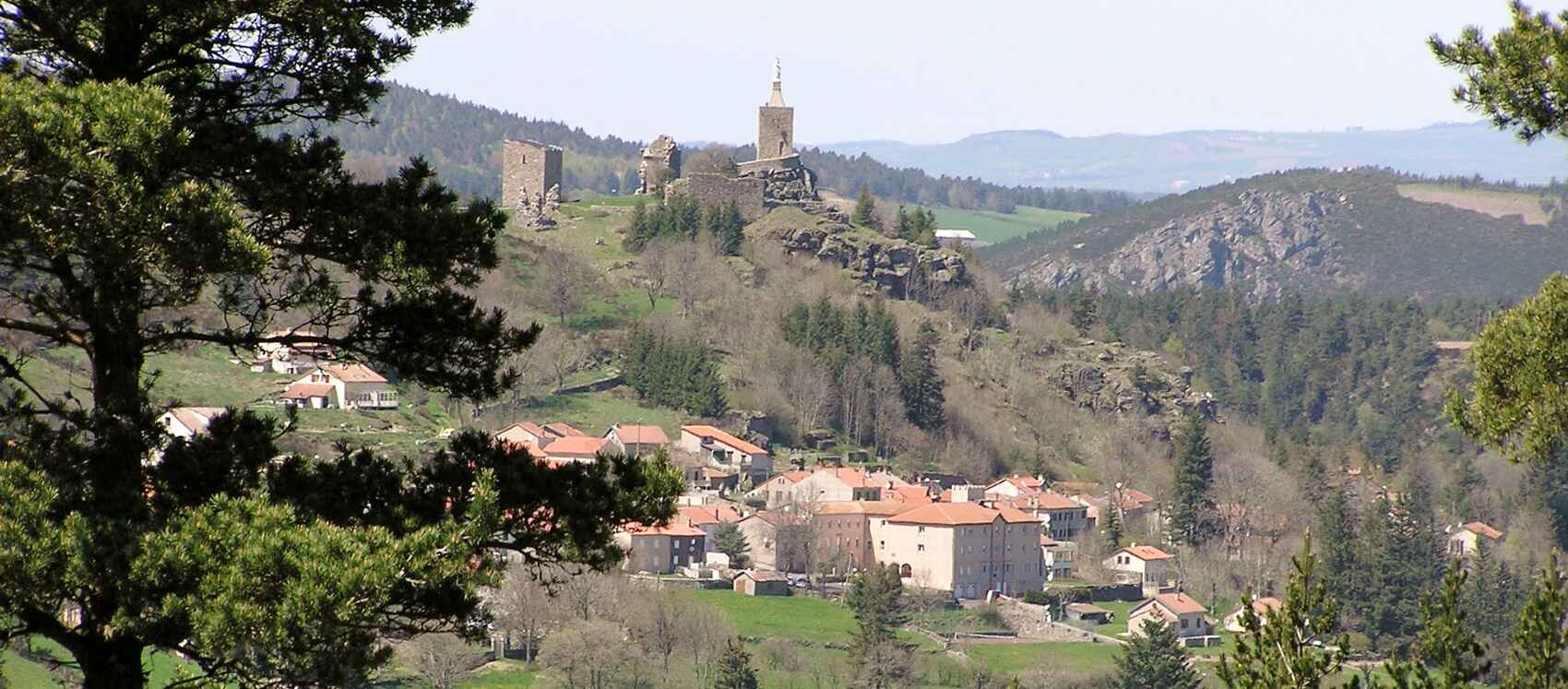
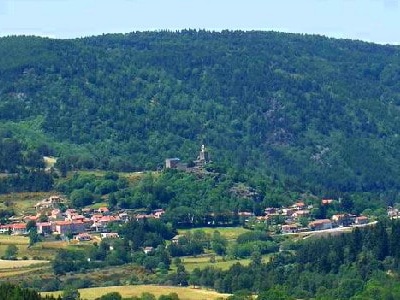 Luc (from lucus, sacred wood) certainly has a very ancient origin. Its hospital and church, from the 12th or 13th century, constituted a priory that depended on the Aubrac domain. In the main street, at the corner of a house, near the post office, a small statuette from the 14th century, the "Cagassou," represents a man squatting in an unambiguous position.
Luc (from lucus, sacred wood) certainly has a very ancient origin. Its hospital and church, from the 12th or 13th century, constituted a priory that depended on the Aubrac domain. In the main street, at the corner of a house, near the post office, a small statuette from the 14th century, the "Cagassou," represents a man squatting in an unambiguous position.
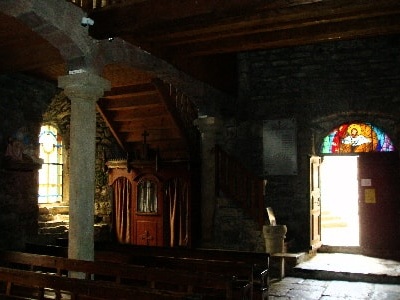 From the castle that overlooks the village (imposing ruins, fishbone walls from the 12th century), there is a panorama. A statue of the Virgin Mary was erected in 1878 on a restored tower. The choir of the church contains some remnants of the 13th-century building. Across the street is the old building of the priory.
From the castle that overlooks the village (imposing ruins, fishbone walls from the 12th century), there is a panorama. A statue of the Virgin Mary was erected in 1878 on a restored tower. The choir of the church contains some remnants of the 13th-century building. Across the street is the old building of the priory.
Between the Cévennes to the South and the Margeride to the North; facing the Tanargue to the East and the Mercoire forest to the West, the Allier River stretches at the foot of the village of Luc, which probably owes its origin to the Mercoire forest that extended throughout the region at the beginning of our era and was dedicated to the worship of the god Mercury. Dominating the village, the ruins of the castle attract the attention of passersby.
Built before the 12th century on a Celtic site, it was one of the most important in the region. Its architecture in "opus spicatum" (ear of grain) is remarkable. Enlarged over the years through alliances, it has retained, despite its current degradation, the imposing signs of a military fortress. Guardian of the Chemin de la Régordane (a link between the Midi and Auvergne, frequently traveled by pilgrims to Saint Gilles), the castle of Luc was a strategic point between the two provinces of Gévaudan and Vivarais.
The Golden Age of the Castle
Until the 13th century, this path (the current street crossing the village) allowed for the development of many artisanal and commercial activities. The castle was then the seat of an important barony belonging to the De Luc family. Subsequently, due to various alliances, it became the domain of the most illustrious noble families of the region: d'Anduze, de Randon, de Polignac, de Muras, de Merle, and de Périer.
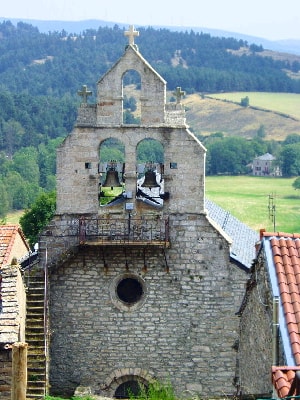 The Hundred Years' War, followed by the Wars of Religion, did not spare the village: attack on the castle by the English and brigands around 1380, looting of the presbytery at the end of the 17th century. These wars led the states of Gévaudan to install "a foot and horse garrison at the castle of Luc." It seems to have been dismantled on the orders of Richelieu around 1630.
The Hundred Years' War, followed by the Wars of Religion, did not spare the village: attack on the castle by the English and brigands around 1380, looting of the presbytery at the end of the 17th century. These wars led the states of Gévaudan to install "a foot and horse garrison at the castle of Luc." It seems to have been dismantled on the orders of Richelieu around 1630.
Oblivion and Renaissance
The Revolution, with the abolition of feudal rights, as well as the harshness of the climate and the challenges of time, have brought it to its current state of degradation. Two important events occurred in the 19th century.
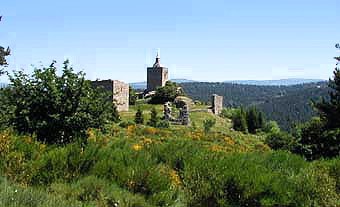 In 1878, the parishioners of Luc transformed the donjon into a chapel and installed a statue of the Virgin Mary on the terrace. At the same time, a Scotsman, Robert Louis Stevenson, with his donkey Modestine, undertook a "Journey through the Cévennes." They passed by the castle and stopped in Luc on September 25, 1878. Coming from Langogne via Cheylard l'Évêque, the Stevenson path or GR®70 runs along the Allier River towards the Abbey of Notre Dame des Neiges (historical variant) and La Bastide-Puylaurent.
In 1878, the parishioners of Luc transformed the donjon into a chapel and installed a statue of the Virgin Mary on the terrace. At the same time, a Scotsman, Robert Louis Stevenson, with his donkey Modestine, undertook a "Journey through the Cévennes." They passed by the castle and stopped in Luc on September 25, 1878. Coming from Langogne via Cheylard l'Évêque, the Stevenson path or GR®70 runs along the Allier River towards the Abbey of Notre Dame des Neiges (historical variant) and La Bastide-Puylaurent.
From then on, the castle and its rich historical past will no longer be mentioned. But in 1978, a few friends decided to give it a place in local life. They founded an association for the preservation and enhancement of the castle of Luc. Its goal is to preserve and restore its remains, but also to deepen its history to make it accessible to a broad audience.
Since then, a joint will of the municipality and the association has allowed for restoration campaigns to be undertaken. Soon, one will be able to climb to the top of the high tower, from where one can admire the entire chain of the Puys and the peaks of Vivarais and Velay.
The History
of the Village
In the 18th and 19th centuries, mule caravans regularly used the way of the Régordane and stopped in Luc. The same was true for transhumant herds: several thousand heads grazed every year. It was the railway that allowed Luc to become an important tourist station, especially appreciated by those from the south.
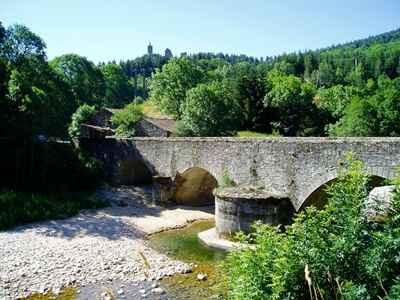 Some architectural remnants still exist in the village.
Some architectural remnants still exist in the village.
The calvary, built in 1904, and the Romanesque church, partly rebuilt in 1834 while retaining its core and its capitals from the 13th century. A porch opposite the church, topped with a Maltese cross (1825) and the facade of the old priorate adjacent to the church (1776). A door lintel, facing the scale (former vicarage) (1871) and a sculpture from the 14th century. "Le Marmouset," near the post office.
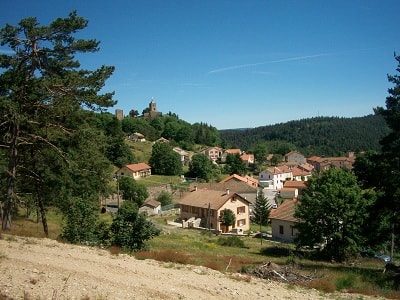 A stone cross topped with a coat of arms near the fountain in the middle of the village and a vault key (coat of arms of an abbot of Chambons) near the old sawmill after the station. The remains of an old mill, attached under the dam below the station, some crosses, reminders of ecclesiastical missions from the beginning of the century, and some statues from the former congregational schools that were previously installed in Luc...
A stone cross topped with a coat of arms near the fountain in the middle of the village and a vault key (coat of arms of an abbot of Chambons) near the old sawmill after the station. The remains of an old mill, attached under the dam below the station, some crosses, reminders of ecclesiastical missions from the beginning of the century, and some statues from the former congregational schools that were previously installed in Luc...
The Régordane Way (currently GR®700), ancestral, would be the cévenole section of the old road from Paris to lower Languedoc, which crossed the Central Massif through Clermont, Brioude, Le Puy-en-Velay, Pradelles, Lesperon, Luc, La Bastide-Puylaurent, Prévenchères, Villefort, Génolhac, Chamborigaud, Alès, Nîmes, and Saint-Gilles.
This name "Régordane" only applied to the portion between Alès and Luc. It witnessed thousands of transhumants, processions of
Phoenicians, Greeks, Romans, warriors, pilgrims who left from Orléans to reach the famous abbey of Saint-Gilles, merchants traveling from north to south to sell cloth and textiles from Flanders or from south to north to transport products from the East, spices, precious fabrics, and, in 1295, Genoese sailors enlisted by the King of France to invade
England...
"Régordane" was also the name of a family that, in the 12th, 13th, and 15th centuries, included several legal members in Montpellier and Alès. This royal road was supplanted after the 15th century by the straight road of the Rhône valley. Association "Friends of the Castle of Luc".
Luc: A number of toponyms based on Latin names of plants belong to the Gallo-Roman period: this is the case with the Latin Lucus "sacred wood, forest" as the origin of many Luc but also Lux (7 municipalities and place names) and Luz in Old French (21 municipalities and place names). Since a Celtic occupation is proven, one might also think of the god Lug, "Lugh" in Irish, identified with Mercury; (Lyon = "Lugdunum," the city [fortified] of Lug; the same etymology for the cities of Laon, Loudun, Loudon). See "St Etienne de Lugdarès".
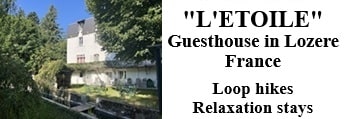
Former holiday hotel with a garden along the Allier, L'Etoile Guest House is located in La Bastide-Puylaurent between Lozere, Ardeche, and the Cevennes in the mountains of Southern France. At the crossroads of GR®7, GR®70 Stevenson Path, GR®72, GR®700 Regordane Way, GR®470 Allier River springs and gorges, GRP® Cevenol, Ardechoise Mountains, Margeride. Numerous loop trails for hiking and one-day biking excursions. Ideal for a relaxing and hiking getaway.
Copyright©etoile.fr

 Luc (from lucus, sacred wood) certainly has a very ancient origin. Its hospital and church, from the 12th or 13th century, constituted a priory that depended on the Aubrac domain. In the main street, at the corner of a house, near the post office, a small statuette from the 14th century, the "Cagassou," represents a man squatting in an unambiguous position.
Luc (from lucus, sacred wood) certainly has a very ancient origin. Its hospital and church, from the 12th or 13th century, constituted a priory that depended on the Aubrac domain. In the main street, at the corner of a house, near the post office, a small statuette from the 14th century, the "Cagassou," represents a man squatting in an unambiguous position. From the castle that overlooks the village (imposing ruins, fishbone walls from the 12th century), there is a panorama. A statue of the Virgin Mary was erected in 1878 on a restored tower. The choir of the church contains some remnants of the 13th-century building. Across the street is the old building of the priory.
From the castle that overlooks the village (imposing ruins, fishbone walls from the 12th century), there is a panorama. A statue of the Virgin Mary was erected in 1878 on a restored tower. The choir of the church contains some remnants of the 13th-century building. Across the street is the old building of the priory. The Hundred Years' War, followed by the Wars of Religion, did not spare the village: attack on the castle by the English and brigands around 1380, looting of the presbytery at the end of the 17th century. These wars led the states of Gévaudan to install "a foot and horse garrison at the castle of Luc." It seems to have been dismantled on the orders of Richelieu around 1630.
The Hundred Years' War, followed by the Wars of Religion, did not spare the village: attack on the castle by the English and brigands around 1380, looting of the presbytery at the end of the 17th century. These wars led the states of Gévaudan to install "a foot and horse garrison at the castle of Luc." It seems to have been dismantled on the orders of Richelieu around 1630. In 1878, the parishioners of Luc transformed the donjon into a chapel and installed a statue of the Virgin Mary on the terrace. At the same time, a Scotsman, Robert Louis Stevenson, with his donkey Modestine, undertook a "Journey through the Cévennes." They passed by the castle and stopped in Luc on September 25, 1878. Coming from Langogne via Cheylard l'Évêque, the Stevenson path or GR®70 runs along the Allier River towards the Abbey of Notre Dame des Neiges (historical variant) and La Bastide-Puylaurent.
In 1878, the parishioners of Luc transformed the donjon into a chapel and installed a statue of the Virgin Mary on the terrace. At the same time, a Scotsman, Robert Louis Stevenson, with his donkey Modestine, undertook a "Journey through the Cévennes." They passed by the castle and stopped in Luc on September 25, 1878. Coming from Langogne via Cheylard l'Évêque, the Stevenson path or GR®70 runs along the Allier River towards the Abbey of Notre Dame des Neiges (historical variant) and La Bastide-Puylaurent. Some architectural remnants still exist in the village.
Some architectural remnants still exist in the village. A stone cross topped with a coat of arms near the fountain in the middle of the village and a vault key (coat of arms of an abbot of Chambons) near the old sawmill after the station. The remains of an old mill, attached under the dam below the station, some crosses, reminders of ecclesiastical missions from the beginning of the century, and some statues from the former congregational schools that were previously installed in Luc...
A stone cross topped with a coat of arms near the fountain in the middle of the village and a vault key (coat of arms of an abbot of Chambons) near the old sawmill after the station. The remains of an old mill, attached under the dam below the station, some crosses, reminders of ecclesiastical missions from the beginning of the century, and some statues from the former congregational schools that were previously installed in Luc...